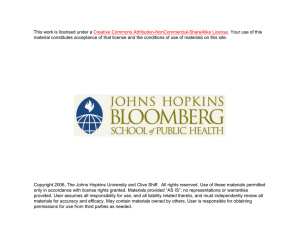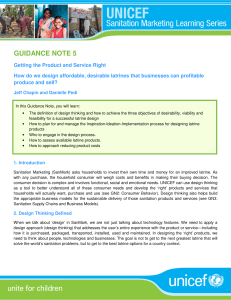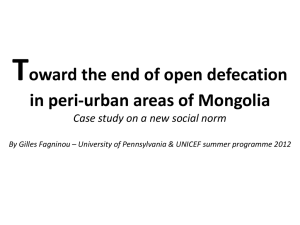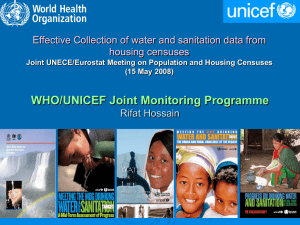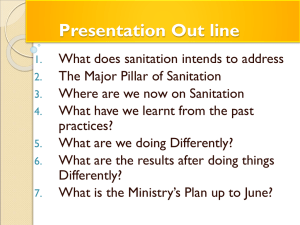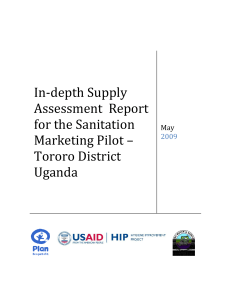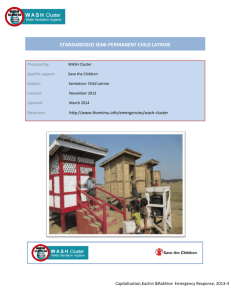Marketing Mix: Product
advertisement
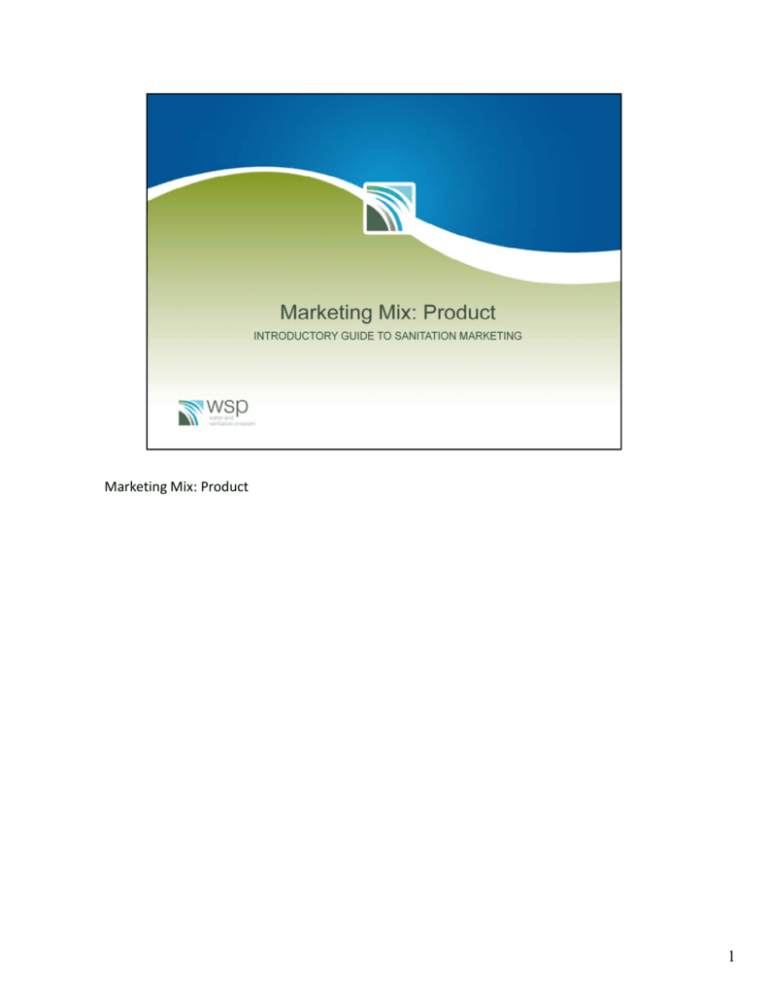
Marketing Mix: Product 1 The learning objectives for this module include understanding ‐‐ the steps to develop a marketing strategy ‐‐ what is meant by ‘marketing mix’ ‐‐ guiding principles behind developing a product strategy ‐‐ challenges in applying these principles to sanitation, and ‐‐ some strategic options 2 Once the results of the formative research are available, the next step is to identify goals and develop the marketing strategy. A marketing strategy typically has a 3 to 5 year horizon and is supported by annual marketing plans that include a detailed action plan and timeline, a budget, and monitoring plan. 3 The sanitation marketing strategy is based on the “Four Ps” of marketing, known as the marketing mix. The Four P’s are product, price, promotion, and place. 4 What does “product “ mean in the context of sanitation marketing? A product can be a physical product such as a latrine or a service such as pit emptying. A product can also be an idea or a behavior such as cleaning a toilet– to learn more, see the Promotion and Communication modules. 5 Here are some principles to keep in mind. These are based on decades of experience in commercial and social marketing. First, sanitation products should respond to customers’ needs as much as possible. Products should have the desired features and benefits – these can be identified through research. For example, in the Mekong region of Singapore, some segments of the population practice open defecation in a local river. The NGO Lien Aid developed a floating hygienic toilet that features the sound of the waves and water. Human‐centered design uses extensive field‐testing to ensure that users’ needs and expectations are met. 6 Second, think in terms of benefits rather than features. Features refer to a product’s attributes or technical specifications. Benefits refer to what these features offer to the customer. For example, a ventilated improved pit latrine or “VIP latrine” has a mosquito screen and ventilation – these are its main features. But a more useful way to describe a VIP latrine is through the lens of the customer ‐‐ a VIP latrine offers freedom from annoying insects and unpleasant odors. A slab may be non‐porous but what matters to the customer is that it is easy to clean and may last longer! 7 The key to developing products is to understand what benefits are important to the customer. For example, to develop the Easy Latrine in Cambodia, IDEO and partners developed a benefits ladder based on information collected during the field testing. The ladder identifies groups or clusters of benefits customers want at various price points. For example, at the minimum cost of $15, customers want privacy, safety, convenience, no smell, no bugs. For more money, users want increasing shelter permanence and status. From a marketing perspective, developing a benefits ladder is more operational than the sanitation ladder, which plots technology options. Rather than focusing on features and technical specifications, direct product development based on what features are desired ,and at what price. 8 One point related to the principle of “Think benefits not features” is to understand the difference between options and products. Technology options refer to specifications such as what is below the ground – the substructure, what is at ground level – such as a slab ‐ and what is above the ground – or the superstructure. Products in the marketing sense refer to the benefits. 9 In the sanitation sector, program managers tend to focus on the substructure but studies show that what often matters to customers is what is visible and tangible, not what is hidden below the surface. 10 When it comes to products, less may be best, so long as the products are need‐ responsive. This principle may go against conventional wisdom in the water and sanitation sector ‐‐ that the more products available, the better. Many “technology option catalogs” present dozens of possible product configurations. While customers may desire choice, there may come a point too many options may confuse and overwhelm customers, particularly at a given price‐point or for a given segment. For example, research in Benin and Ghana showed that non‐adopters found options to be complex. The less‐is‐best principle has been applied in the social arena– for example is in social marketing programs to promote condom use. Typically, a single brand is introduced in a country. Over time, as the product matures and new customer segments are identified, additional products and brands are introduced. 11 Here are the challenges: Many program managers have limited influence and do not “control” the product, especially because they are not in the sales, distribution, or even product design business. An array of technological options above, at, or below the ground often result in too many combinations. When awareness of options is low or social aspirations are high, the most desired features and benefits of the “ideal” toilet may be out of reach for most rural households, particularly the poorest segments. 12 Keeping the principles and challenges in mind, there are several strategies available. Note that they are not mutually exclusive. The first option is standardization, which follows the less is best principle. Standardization is used in social and commercial marketing. A Big Mac™ for example, is the same whether you order it in New York City, Jakarta, or Johannesburg. Standardization can offer potential economies of scale in several areas such as promotion and distribution. Standardization has been used successfully in Tanzania where 80% of the households had a simple pit latrine by 2008. Findings from a household survey suggested a more homogeneous market in which, at least initially, market segmentation was not needed. To move households up the sanitation and benefits ladders, WSP chose to use SanPlat, a concrete latrine slab that could be integrated into an existing latrine. Training of masons has focused on how to make and sell the SanPlat and how to retrofit a latrine. All of the communication materials focus on this single product. 13 Modularization involves standardizing the product, but in a way that allows for households to upgrade over time, as needs and budget evolve. In East Java, for example, a sanitarian developed a range of four products , allowing households to upgrade over time from the basic configuration. This approach is now being replicated by other suppliers. Keep in mind is that modularization, as any product decision, must be informed by research. This strategy might not be a good one if the research suggests that households may prefer to save up and then get their preferred model rather than upgrade over time. 14 Another strategy is to focus on a few products. Based on insights from formative research from both the supply and demand sides, you may choose a few options to focus promotion and training on. This strategy is particularly appropriate if distinct segments have been identified, differing for example on their needs or purchasing power, or if there are hydro‐ geological factors to consider. To illustrate this approach in practice, IDE during a sanitation marketing pilot project in Vietnam, focused promotion and training of providers on four toilet models. 15 A natural progression from standardization and modularization is to develop a brand name f for a product. d To understand the power of branding, imagine going into a popular burger restaurant and ordering a “double beef patty with 3 bread slices, 2 slices of cheese, lettuce, ketchup, pickle and special sauce” instead of a Big Mac. Now imagine a supplier informing a rural household member about, say, a “Royal Highness instead of Highness” instead of “aa double offset pour‐flush latrine with ceramic pan. double offset pour flush latrine with ceramic pan ” Branding allows Branding allows you to focus on the product’s benefits rather than its technical specifications. Branding can also allow you to tap into insights from formative research and appeal to aspirations. Branding can also lead to potential economies of scale in advertising and other communication efforts, in training suppliers and in distribution. The brand doesn’t need to be a formal trademark or a commercial registration. It can be what we call “a soft brand”. For example, in Tanzania, WSP and partners are promoting SanPlat For example, in Tanzania, WSP and partners are promoting SanPlat under the name of under the name of Sungura. Sungura means rabbit in Kiswahili, referring to what the slab’s features look like. In promotional materials and during the mason training the slab is referred to as a Sungura. This ensures consistency and synergy across the various components of the sanitation marketing program. 16 Fostering product innovation may be beneficial or even needed under certain circumstances. circumstances For example, say locally‐made slabs tend to be porous and research has told us consumers find them hard to clean. Many sanitation marketing programs to date have expected innovation to happen naturally or organically from trained masons. However, there is little data to suggest mason training is helpful in generating innovation that meets the needs of consumers at large scale. Try exploring others approaches for fostering innovation at scale. Some ideas include partnering with innovation foundations to create incentives or providing technical assistance to organizations so that they can submit strong proposals to enter innovations competitions. Providing technical assistance in human‐centered design to appropriate in‐country partners is another possibility. In Cambodia, WSP partnered with international NGO IDE and human‐centered design firm IDEO to develop an affordable and simple latrine core which would confer the benefits of a pour‐flush but cost far less thanks to a streamlined design and production. You can learn more about the Easy Latrine’ in Tools & Resources. Keep in mind that an innovation does not need to be indigenous– sometimes ensuring a product is imported from another country can be sufficient. 17 Before ending this module, I want to point out the importance of thinking beyond the installation of the toilet and thinking through what products and services are needed throughout its life cycle. One of the recommendations of the 2009 assessment carried out by WSP and IRC on the sustainability of the Vietnam IDE sanitation marketing pilot project, was that long term maintenance services such as septic tank emptying need to be developed at the same time as the toilets. Other products may also need to figure in the marketing mix. Handwashing stations, products to help households better manage their children’s feces or menstrual waste should be considered. For example, in Tanzania, WSP has trained masons to build tippy taps in addition to the Sungura slabs, thereby potentially increasing their revenue stream while enabling households to wash their hands with soap more conveniently. 18 19
